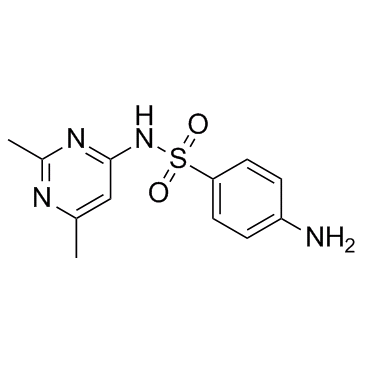sulfisomidine

sulfisomidine structure
|
Common Name | sulfisomidine | ||
|---|---|---|---|---|
| CAS Number | 515-64-0 | Molecular Weight | 278.330 | |
| Density | 1.4±0.1 g/cm3 | Boiling Point | 480.7±55.0 °C at 760 mmHg | |
| Molecular Formula | C12H14N4O2S | Melting Point | 245ºC | |
| MSDS | Chinese USA | Flash Point | 244.5±31.5 °C | |
| Symbol |

GHS07 |
Signal Word | Warning | |
|
Fast determination of 22 sulfonamides from chicken breast muscle using core-shell nanoring amino-functionalized superparamagnetic molecularly imprinted polymer followed by liquid chromatography-tandem mass spectrometry.
J. Chromatogr. A. 1345 , 17-28, (2014) A novel, simple and sensitive method was developed for the simultaneous determination of 22 sulfonamides (SAs) in chicken breast muscle by using the dispersive micro-solid-phase extraction (d-μ-SPE) procedure combined with ultra-fast liquid chromatography-tan... |
|
|
Multiresidue analysis of sulfonamides, quinolones, and tetracyclines in animal tissues by ultra-high performance liquid chromatography-tandem mass spectrometry.
Food Chem. 204 , 252-62, (2016) A multiresidue method for the efficient identification and quantification of 38 compounds from 3 different classes of antibiotics (tetracyclines, sulfonamides, and quinolones) in animal tissues has been developed. The method optimization involved the selectio... |
|
|
Coulometric determination of sulphisomidine, sulphamethoxydiazine and sulphamoxole.
J. Pharm. Biomed. Anal. 9(2) , 199-201, (1991)
|
|
|
Identification of the 'wrong' active pharmaceutical ingredient in a counterfeit Halfan drug product using accurate mass electrospray ionisation mass spectrometry, accurate mass tandem mass spectrometry and liquid chromatography/mass spectrometry.
Rapid Commun. Mass Spectrom. 17(3) , 215-21, (2003) Methodology is presented for identifying an unknown active (pharmaceutical) ingredient (AI) in a counterfeit drug product. A range of mass spectrometric techniques, i.e., accurate mass mass spectrometry, tandem mass spectrometry (MS/MS) and liquid chromatogra... |
|
|
Lack of oxidative pathways in the metabolism of sulphisomidine by the turtle Pseudemys scripta elegans.
J. Vet. Pharmacol. Ther. 12(4) , 459-62, (1989)
|
|
|
Extended Hildebrand solubility approach: solubility of tolbutamide, acetohexamide, and sulfisomidine in binary solvent mixtures.
J. Pharm. Sci. 71(4) , 439-42, (1982) The extended Hildebrand approach for predicting solubilities of crystalline compounds in solvent mixtures was tested using tolbutamide, acetohexamide, and sulfisomidine in mixed solvents consisting of hexane-absolute ethanol and 95% (v/v) ethyl alcohol-aqueou... |
|
|
Direct drug transport from the rat nasal cavity to the cerebrospinal fluid: the relation to the dissociation of the drug.
J. Pharm. Pharmacol. 46(5) , 378-9, (1994) We aimed to clarify the relationship between drug dissociation (sulphisomidine) and its direct transport from the nasal cavity to the cerebrospinal fluid (CSF). Rat nasal cavities were perfused in a single pass system with buffers (pH 5.5, 6.5, 7.4, 8.7 and 9... |
|
|
Effect of different sulfonamides on the human serum complement system.
Int. Arch. Allergy Appl. Immunol. 76(3) , 205-13, (1985) Incubation of normal human serum with different sulfonamides led to a dose-dependent inactivation of total hemolytic complement activity. A decrease of the activities of C1, C2, C3, C5 and one or several of the components C6-9 was observed after treatment of ... |
|
|
Renal tubular excretion of the N4-acetyl metabolites of sulphasomidine and sulphadimethoxine in the dog.
J. Pharm. Pharmacol. 45(7) , 614-7, (1993) To investigate whether dogs are able to excrete acetylated drugs by active transport, the plasma kinetics and renal excretion of the N4-acetyl metabolites of sulphasomidine and sulphadimethoxine were studied in the beagle dog after a rapid intravenous bolus i... |
|
|
Antibiotic susceptibility pattern and capsular types of Haemophilus influenzae recovered from clinical specimens in northern Norway.
Acta Pathol. Microbiol. Immunol. Scand. B. 91(6) , 383-7, (1983) One hundred and nine strains of Haemophilus influenzae recovered from clinical specimens were examined for antibiotic sensitivity pattern and capsular types. All strains from blood cultures, cerebrospinal fluid and a joint aspirate were type b whereas most of... |